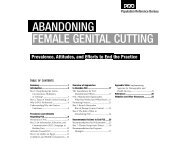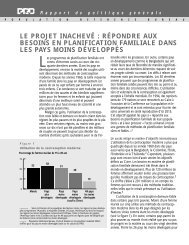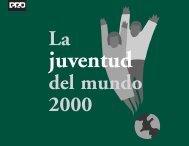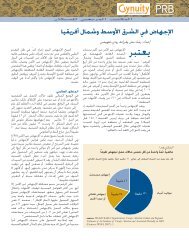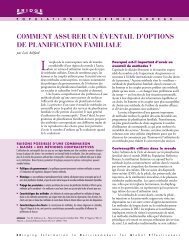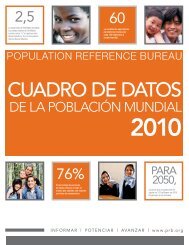Immigration Shaping America - Population Reference Bureau
Immigration Shaping America - Population Reference Bureau
Immigration Shaping America - Population Reference Bureau
Create successful ePaper yourself
Turn your PDF publications into a flip-book with our unique Google optimized e-Paper software.
28<br />
to improving conditions at the bottom<br />
of the labor market through<br />
employment and training programs<br />
for less-skilled workers and affirmative<br />
action for workers from groups that<br />
suffered discrimination in the past.<br />
Economists and other social scientists<br />
have used three kinds of studies<br />
to examine the labor market effects<br />
of immigrants in detail: case studies,<br />
econometric studies, and economic<br />
mobility or integration studies.<br />
Case Studies<br />
Case studies examine a particular<br />
industry or occupation. Many of the<br />
first immigration studies were case<br />
studies that were undertaken after<br />
U.S. workers went on strike and were<br />
replaced by immigrants. When farm<br />
workers in Southern California went<br />
on strike for a wage increase in 1982,<br />
for example, many lost their jobs. The<br />
unionized workers were displaced in a<br />
competition between employers. The<br />
unionized harvesting association lost<br />
business to farm labor contractors<br />
(FLCs) who hired nonunion and<br />
often unauthorized workers. The<br />
harvesting association went out of<br />
business, and the union workers lost<br />
their jobs. 42<br />
Case studies have shown that immigration<br />
can displace established<br />
workers and depress wages by adding<br />
vulnerable workers to the labor<br />
supply. This scenario conforms to<br />
accepted labor market theory, but the<br />
actual effects on wages and employment<br />
are indirect and hard to measure.<br />
43 Once employers begin hiring<br />
newly arrived workers through FLCs,<br />
for example, hiring and supervision<br />
can change. Local workers may not<br />
learn about job vacancies if the FLCs<br />
find additional workers by asking<br />
current employees to bring in their<br />
friends and relatives. Such network<br />
hiring helps explain why many garment<br />
shops in New York or Los Angeles<br />
have Mexican, Chinese, or Thai<br />
seamstresses, but not a mixture of the<br />
three. Network hiring also explains<br />
how the owners of office buildings<br />
in Los Angeles in the 1980s came to<br />
replace unionized U.S.-born black janitors<br />
with immigrants hired by cleaning<br />
contractors.<br />
Econometric Studies<br />
Econometric studies consider how<br />
immigration, wages, and employment<br />
interact in a city labor market, or they<br />
compare labor markets among cities.<br />
They begin with the assumption that,<br />
if immigrants depress wages or displace<br />
workers, then the more immigrants<br />
there are in a city, the greater<br />
the observed wage depression or job<br />
displacement will be. Econometric<br />
studies might study the influence of<br />
immigration on the wages and unemployment<br />
rates of blacks, Hispanics,<br />
and women in Los Angeles by comparing<br />
them with similar groups in<br />
Atlanta, which has a relatively small<br />
immigrant population.<br />
In the 1980s, to the surprise of<br />
economists, such studies found few<br />
wage or labor market effects related<br />
to immigration. In 1990, economist<br />
George Borjas summarized the research<br />
literature by saying that “modern<br />
econometrics cannot detect a<br />
single shred of evidence that immigrants<br />
have a sizable adverse impact<br />
on the earnings and employment<br />
opportunities of natives in the United<br />
States.” 44 One well-known econometric<br />
study concluded, for example, that<br />
the 1980 influx of Cuban immigrants<br />
to Miami in the Mariel boatlift had<br />
no measurable negative effect on the<br />
wages and employment of local workers.<br />
During the four months of the<br />
boatlift, Miami’s labor force increased<br />
by 7 percent, but there were no significant<br />
differences between wage and<br />
job opportunities for native-born<br />
workers in Miami and in other U.S.<br />
cities. 45 The evidence suggested that<br />
the immigrants generated enough<br />
economic activity to offset any negative<br />
effects their presence might have<br />
on the wages or job prospects of local<br />
workers.<br />
As more data became available<br />
in the 1990s, however, researchers<br />
were able to measure some of the<br />
labor market and wage effects of<br />
immigration that economic theory<br />
predicted. The most important new




